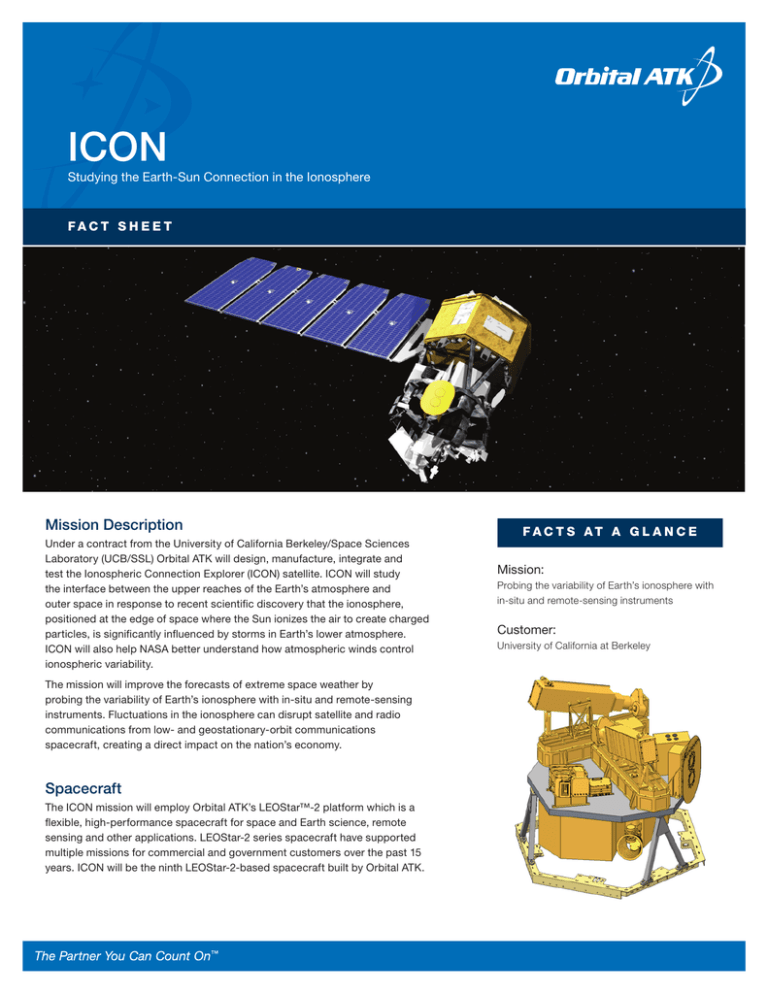
ICON
Studying the Earth-Sun Connection in the Ionosphere
FACT SHEET
Mission Description
Under a contract from the University of California Berkeley/Space Sciences
Laboratory (UCB/SSL) Orbital ATK will design, manufacture, integrate and
test the Ionospheric Connection Explorer (ICON) satellite. ICON will study
the interface between the upper reaches of the Earth’s atmosphere and
outer space in response to recent scientific discovery that the ionosphere,
positioned at the edge of space where the Sun ionizes the air to create charged
particles, is significantly influenced by storms in Earth’s lower atmosphere.
ICON will also help NASA better understand how atmospheric winds control
ionospheric variability.
The mission will improve the forecasts of extreme space weather by
probing the variability of Earth’s ionosphere with in-situ and remote-sensing
instruments. Fluctuations in the ionosphere can disrupt satellite and radio
communications from low- and geostationary-orbit communications
spacecraft, creating a direct impact on the nation’s economy.
Spacecraft
The ICON mission will employ Orbital ATK’s LEOStar™-2 platform which is a
flexible, high-performance spacecraft for space and Earth science, remote
sensing and other applications. LEOStar-2 series spacecraft have supported
multiple missions for commercial and government customers over the past 15
years. ICON will be the ninth LEOStar-2-based spacecraft built by Orbital ATK.
FAC T S AT A G L A N C E
Mission:
Probing the variability of Earth’s ionosphere with
in-situ and remote-sensing instruments
Customer:
University of California at Berkeley
ICON
Specifications
Mission Partners
Spacecraft
University of California at Berkeley/Space Sciences Laboratory
Principal investigator: Dr. Thomas Immel; mission management,
science and mission operations, EUV & FUV instruments; payload
integration and test
Launch Mass: 272 kg (600 lb.)
Redundancy: Single String
Solar Arrays: 780 W, Articulated Arrays
Stabilization: 3 Axis, Zero Momentum Bias
Pointing:
144 arcsec control
108 arcsec knowledge
Data Storage:
16 Gbit
Data Downlink:
S-band: 3.5 Mbps
Naval Research Laboratory
Orbit: 575 km circular @ 27° Inclination
MIGHTI instrument
Mission Life: Two Years
Orbital ATK
Spacecraft development, observatory integration and test, launch
operations
University of Texas at Dallas
Launch
Launch Vehicle: Pegasus XL
Launch Site:
Reagan Test Site, Kwajalein Island
Date: 2017
IVM instrument
Instruments
•
ichelson Interferometer for Global High-Resolution
M
Thermospheric Imaging (MIGHTI) will detect the aurora-like
glow of air molecules in the thermosphere and measure their
temperature and speed via doppler imaging.
•
xtreme Ultraviolet imager (EUV) will provide images of the
E
upper atmosphere in extreme ultraviolet spectrum.\
•
ar Ultraviolet imager (FUV) will provide images of the upper
F
atmosphere in the far ultraviolet spectrum.
•
Ion Velocity Meter (IVM) will measure in-situ the charged
particles and flowing plasma.
OrbitalATK.com
©2015 Orbital ATK. All Rights Reserved. FS010_13_OA_3862
